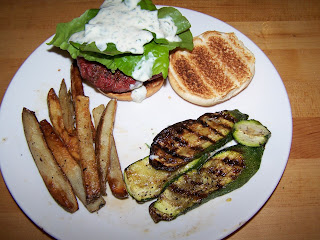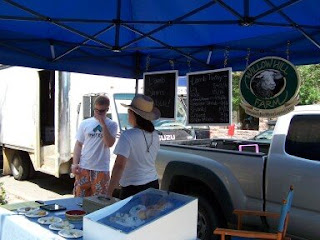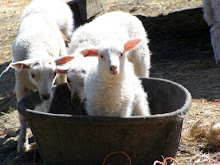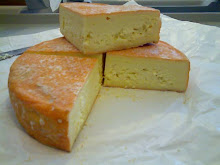To say that "pork fat rules" is an understatement by Emeril Lagasse. I love pork. I love it alone and combined with other meats. It has a succulent, slightly salty, wonderful mouthfeel, the fat, that is.
We raise lamb and when I make lamb meatballs for spaghetti in red sauce, I enjoy the pure lamb meat, meatballs, but I cherish the meatballs with a little ground pork added. Of course I add a tad of our own milk to the mix too!
Our lamb, similar to Basque style lamb, is a little leaner than standard American lamb, so adding a small amount of ground pork helps add moisture and tenderness to the meatballs. Anyway, back to pork. It's so darn hot here in Northern Vermont right now that I figured, "if you can't beat 'em, join 'em.".............hence, the desire in the HHH (Hazy Hot and Humid temps) to barbecue some pork in true Southern style and enjoy this lazy day of summer. Wait! What? Lazy day? No whey! We made sheep yogurt today, Sunday. So another 9 hours in heat.......... This means that on a 90 degree day in Vermont, we were relaxingly donned in our rubber gloves and rubber aprons in an 85 degree room at about 90 percent humidity. Steamy is more like it!
Back to pork. I adore barbeque. I also relish grilling. What's the difference? **See notes below........I started out with the proverbial Hibachi on the ground in college. Then graduated to a gas Weber grill. Then inherited a Weber bubble charcoal grill when my mother moved away. I started out of curiosity to cook foods on the charcoal Weber. I never went back. Relegated the old gas Weber to the back of the garage and it's never seen the light of day, since. I would post a picture, but it might be sacrilege for some, so I'll refrain.
Consequently after grilling on the charcoal Weber for 3 years I noticed an ad in Fine Cooking Magazine for a
Big Green Egg. This is a ceramic 'cooker', so it's called. But don't let that fool you. It excels in grilling, smoking and roasting. There are other brands of this Kamado type cooker on the market. I ended up in my obsessive hunt for one buying a
Primo brand ceramic cooker (grill/smoker). These cookers can do direct cooking, indirect cooking, and smoking-even high heat cooking for a grilled pizza. They use charcoal, like the Weber bubble, however, the hardwood kind. This is lump charcoal, and will give your food an indescribable flavor. I know no one who has made the switch that goes back to briquets or gas. Yikes! I sound like I am pitching. Back to pork.
I 'cook out' as they say almost 365 days a year, here, in Vermont. I make lamb, pork, beef, fish and pizzas on the Primo. When it's storming, like a N'oreaster(whipping winds, below zero temps etc), then I make something else inside the house.
Here is the St Louis Style ribs with the fell (that thin skin next to the bones, sort of blueish, that needs to be removed prior to barbecuing-just pull a small amount with a knife, and using a paper towel pull the whole thing off in one fell swoop)...........pulled off with a paper towel, and rubbed with
Dizzy Pig dry rub.

I like to make homemade dry rubs for meats, however,
I really appreciate being able to order the Dizzy Pig dry rubs online if I need to, in a pinch. Another favorite bbq product of mine is the
Billy Bar. This tool, is exceptional at cleaning any kind of grates on any grill/smoker. Be it gas or charcoal. It is as good as sliced bread! This tool, is a small rod-like shape on a handle. Here, the bar cleans the grates.
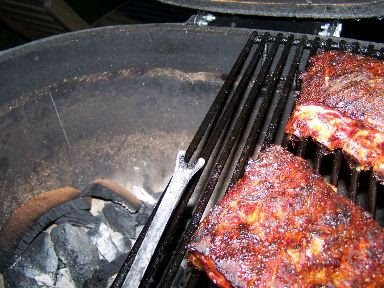
Notice the V-shape of the bar. It gets in the grates and around to clean the gunk and will work on any type of grill, gas or charcoal. It has a stay-cool handle and can be wiped off with a paper towel. It beats those brass brushes that never last.
Barbeque vs. grilling: Barbeque is anything that is slow cooked, low & slow at about 250-300F. Grilling, on the other hand, is high heat, or not, direct or indirect cooking on a grill. Barbeque, for me, is pork ribs, beef brisket, spatchcocked chicken, slow roasted lamb and/or game meats.

